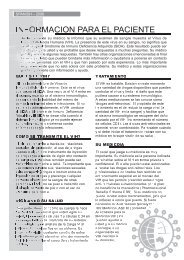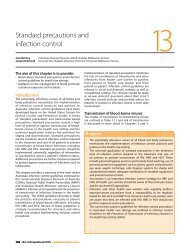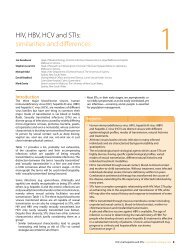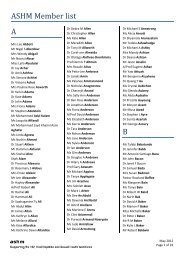B Positive – all you wanted to know about - ASHM
B Positive – all you wanted to know about - ASHM
B Positive – all you wanted to know about - ASHM
You also want an ePaper? Increase the reach of your titles
YUMPU automatically turns print PDFs into web optimized ePapers that Google loves.
e targeting different aspects of the disease<br />
process such as: altered viral replication 4,5 antiinflamma<strong>to</strong>ry<br />
actions 6 and chemoprevention<br />
of malignant change. 7,8 if proven, these actions<br />
would be useful adjuncts <strong>to</strong> the standard<br />
antiviral therapies in chronic hepatitis b. these<br />
agents are also used in symp<strong>to</strong>m management<br />
during antiviral treatment and more gener<strong>all</strong>y<br />
<strong>to</strong> improve quality of life and wellbeing. 8<br />
The pharmacological actions<br />
of complementary medicines<br />
traditional chinese medicine (tcM) and western<br />
herbal medicine use a number of plant-based<br />
chemicals with synergistic and overlapping<br />
pharmacological actions. Herbal medicines<br />
are chosen for their intrinsic characteristics <strong>to</strong><br />
treat diseases, regulate yin and yang and help<br />
the body <strong>to</strong> re-establish normal physiological<br />
function and res<strong>to</strong>re health. 9<strong>–</strong>11<br />
Studies demonstrating specific<br />
activities relevant <strong>to</strong> HBV<br />
management include:<br />
Activity on viral replication<br />
a flavonoid (wogonin) isolated from the<br />
traditional chinese medicinal plant scutellaria<br />
baicalensis (baical skullcap) suppressed<br />
Hbsag production in a HbV transfected liver<br />
cell line (Ms-G2) and inhibited duck HbV dna<br />
polymerase in HbV infected ducks. 12<br />
a study examining the effect of another<br />
flavonoid (apigenin) isolated from ocium<br />
basilicum (sweet basil) showed this agent had<br />
the capacity <strong>to</strong> reduce the production and<br />
release of Hb s and e antigens in HepG 2.2.15<br />
cell lines using the Xtt assay. this effect was<br />
more marked than that of lamivudine. the<br />
significance of this finding in terms of sustained<br />
viral suppression is un<strong>know</strong>n. 13<br />
a multicentre study of chronic hepatitis b<br />
patients found that two different oxymatrine<br />
preparations administered for 24 weeks<br />
improved HbV dna clearance compared <strong>to</strong><br />
placebo (p = 0.001). no follow-up period was<br />
included in the study pro<strong>to</strong>col or reported in<br />
the research paper. 14<br />
in a sm<strong>all</strong> study, patients receiving 400 mg a day<br />
kurorinone (extracted from sophora flavescens)<br />
intramuscularly (n=45) for three months or<br />
3Miu interferon α 2a (n=49) daily for the first<br />
month and on alternate days for the next<br />
two months showed that aLt normalisation<br />
was achieved in 50% of the kurorinone group<br />
and in 61.3% in the interferon α 2a group<br />
with loss of Hbeag or HbV dna. 15 the 12month<br />
follow-up period showed a sustained<br />
virological response (sVr) of 26.7<strong>–</strong>36.7% in the<br />
kurorinone group compared <strong>to</strong> 44.4<strong>–</strong>46.7%<br />
in the interferon group. 15 no further reports<br />
have been published. no recommendations for<br />
clinical use can be made from these studies.<br />
Anti-inflamma<strong>to</strong>ry activity<br />
tJ-9 (sho-saiko-<strong>to</strong>; Xiao-chai-Hu-tang) is<br />
a Japanese and chinese herbal medicine<br />
which has been widely investigated in both<br />
animal and human studies of liver disease.<br />
in the treatment of HbV it has been shown<br />
<strong>to</strong> significantly reduce liver inflammation<br />
as evidenced by reduced aLt levels 16 and<br />
improved liver his<strong>to</strong>logy (the latter particularly<br />
evident in animal studies). 17-19 the main<br />
ingredients are bupleurum chinensis (chai Hu),<br />
scutellaria baicalensis (baical skullcap; Huang<br />
Qin) and Glycyrrhiza (liquorice; Gan cao) root:<br />
<strong>all</strong> of these ingredients are regarded as potent<br />
anti-inflamma<strong>to</strong>ry agents as well as having<br />
other pharmacological actions. 16,20 However,<br />
there have been <strong>about</strong> 10 case reports of<br />
pneumonitis related <strong>to</strong> sho-saiko-<strong>to</strong> in the past<br />
decade. 21-23 some of these case reports may be<br />
related <strong>to</strong> interactions with interferon-based<br />
therapy. 23<br />
Antifibrotic activity<br />
there are limited but interesting data on the<br />
use of herbal preparations <strong>to</strong> modify fibrosis in<br />
HbV.<br />
in one study, a tcM formulation compound<br />
861 (0.03 mg/mL) significantly inhibited<br />
human hepatic stellate cell (LX-2) proliferation<br />
compared <strong>to</strong> the control. in addition, LX-2<br />
cells exposed <strong>to</strong> cpd 861 (0.01mg/mL) had<br />
significantly lower alpha-smooth muscle actin<br />
(α-sMa) expression (59% at 48 hours [p < 0.05])<br />
and (60% at 72 hours [p < 0.01]) compared <strong>to</strong><br />
b <strong>Positive</strong> <strong>–</strong> <strong>all</strong> <strong>you</strong> <strong>wanted</strong> <strong>to</strong> <strong>know</strong> <strong>about</strong> hepatitis b: a guide for primary care providers 97






